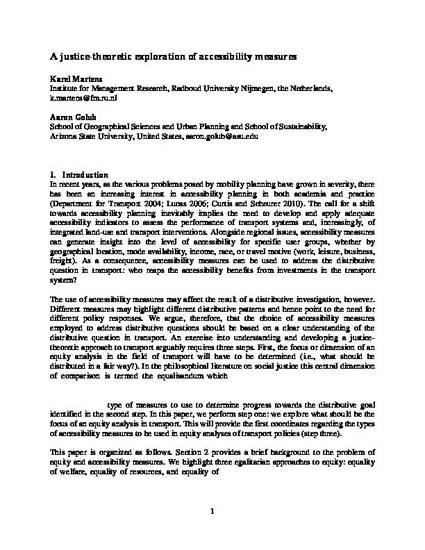
Contribution to Book
A Justice-Theoretic Exploration of Accessibility Measures
Accessibility Analysis and Transport Planning
(2012)
Abstract
In recent years, as the various problems posed by mobility planning have grown in severity, there has been an increasing interest in accessibility planning in both academia and practice (Department for Transport 2004; Lucas 2006; Curtis and Scheurer 2010). The call for a shift towards accessibility planning inevitably implies the need to develop and apply adequate accessibility indicators to assess the performance of transport systems and, increasingly, of integrated land-use and transport interventions. Alongside regional issues, accessibility measures can generate insight into the level of accessibility for specific user groups, whether by geographical location, mode availability, income, race, or travel motive (work, leisure, business, freight). As a consequence, accessibility measures can be used to address the distributive question in transport: who reaps the accessibility benefits from investments in the transport system?
The use of accessibility measures may affect the result of a distributive investigation, however. Different measures may highlight different distributive patterns and hence point to the need for different policy responses. We argue, therefore, that the choice of accessibility measures employed to address distributive questions should be based on a clear understanding of the distributive question in transport. An exercise into understanding and developing a justicetheoretic approach to transport arguably requires three steps. First, the focus or dimension of an equity analysis in the field of transport will have to be determined (i.e., what should be distributed in a fair way?). In the philosophical literature on social justice this central dimension of comparison is termed the “equalisandum”. Second, there is a need to derive a proper distributive goal regarding the equalisandum identified in the first step (i.e., to answer the question: what constitutes a fair distribution of the equalisandum?). Finally, it is necessary to delineate which type of measures to use to determine progress towards the distributive goal identified in the second step. In this paper, we perform step one: we explore what should be the focus of an equity analysis in transport. This will provide the first coordinates regarding the types of accessibility measures to be used in equity analyses of transport policies (step three).
This paper is organized as follows. Section 2 provides a brief background to the problem of equity and accessibility measures. We highlight three egalitarian approaches to equity: equality of welfare, equality of resources, and equality of ‘midfare.’ Each is subsequently discussed in separate sections 3, 4 and 5. In Section 6, we link these approaches to existing accessibility measures. This results in the elimination of a number of measures, which, based on the philosophical arguments presented in the paper, are considered unsuitable as an indicator for equity analyses in the field of transport. We end with a brief conclusion and call for additional, philosophically inspired, research into the relationship between transport, equity and accessibility
Disciplines
Publication Date
2012
Publisher
Edward Elgar Publishing
Publisher Statement
*At the time of publication Aaron Golub was affiliated with Arizona State Univeristy
Citation Information
Martens, K. & Golub, A. (2012). A justice-theoretic exploration of accessibility measures. (pp.
195-210). In: Geurs, K. T., Krizek, K. J., & Reggiani, A. (Eds.), Accessibility Analysis and
Transport Planning: Challenges for Europe and North America (NECTAR Series on
Transportation and Communications Networks Research). Edward Elgar, Cheltenham.
